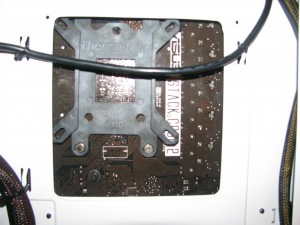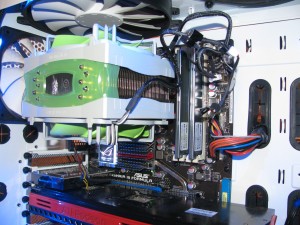Testing
 |
 |
| Note the way the backplate and the access port line up less than perfectly. | Here, you can see the tight clearances around the RAM and the case’s exhaust fan. |
On the subject of our test system, the Jing’s push-pull fans work synergistically with a top-mounted exhaust fan, resulting in a fairly phenomenal amount of air moved with the fans at full speed. However, cubic feet per minute is not the most important detail, core temperature under load is. Our test procedure first involved establishing a baseline temperature of the radiator and the cores immediately after boot, and then repeatedly running 3DMark Vantage until we were confident that the sink was performing adequately under simulated normal usage conditions. This was looped twice, at which point the test was considered passed. All radiator temperatures were determined by inspection with a non-contact thermometer, and recording the maximum temperature detected during the entire inspection (a five-second pass up one side of the exposed heat-sink fins, up to the tops of the heat pipes, and down through the blades of the intake fan).
| Core | Radiator | |
| Baseline | 37° C | 82.1° F |
| After First Run | 89.4 ° F | |
| After Second Run | 38.5° C | 82.0° F |
At this point, we were confident that the heat sink was performing properly, and switched to the real stress-test. Prime95 was used to calculate long prime numbers using every available CPU cycle; our Phenom’s floating-point unit was pegged at 100% utilization for the duration of the test according to our system monitoring software which was running concurrently with Prime95 to provide us with core temperatures. Our prime test began immediately following the Vantage test, allowing only minimal time to load the program. Our first measurement, therefore, is after five minutes of Prime95; additional measurements were taken every five minutes until a temperature plateau was reached.
| Time | Core Temperature | Radiator Temperature |
| 5:00 | 48.1 | 31.2 |
| 10:00 | 48.5 | 31.4 |
| 15:00 | 49.0 | 31.5 |
| 20:00 | 50.0 | 32.0 |
| 25:00 | 50.5 | 31.5 |
After 25 minutes, no increase in temperature larger than the margin of error of our sensors was recorded. This represents more or less the 125 watt CPU being run at its maximum power drain. We then stopped the Prime95 test and stared in amazement at the monitor software’s displays – within 11 seconds, the temperature had already fallen below the temperature measured after boot. At two minutes, the core temperature had fallen to 35° and held steady with a radiator temperature of 28.5°; this is cooler than the baseline temperature we used earlier. The low peak temperature – combined with the startlingly fast plunge as our system loaded – speaks to a very powerful cooler indeed. This is clearly adequate for the most powerful current CPUs, and many of the most powerful next-generation chips that retain compatibility with current sockets.
Verdict
Very quiet, very powerful, and not very expensive. The Jing’s level of performance are awesome. Bang for the buck is fairly good; and nothing else in this performance bracket is significantly cheaper. For $63 shipped on Newegg, you could do quite a bit worse – and at the time of writing, there’s a $10 mail-in rebate from Thermaltake. For its sheer performance, this cooler deserves an award. For doing what it does below the noise floor of our test lab, it definitely deserves an award. For doing so relatively cheaply, it’s getting an award. We at the labs think this is Awesome Hardware. I could spend six paragraphs waxing poetic about the virtues of this cooler and excusing its warts, or I could tell you that this is one of the best air coolers you should be considering for your next processor upgrade. Sure, it’s a little involved to put in, but once you get it there you won’t want to take it off (memory upgrades aside, anyway). The bonus thermal paste is a courteous touch, too. We at the labs have never gone home with a processor, a heat sink, and had to go back to the store for a tube, but I’ve heard of this happening.
Good
- Very powerful
- It’s silent
- It’s relatively inexpensive
Bad
- Some Assembly Required
- Doesn’t fit Intel’s next-generation sockets


You must be logged in to post a comment.